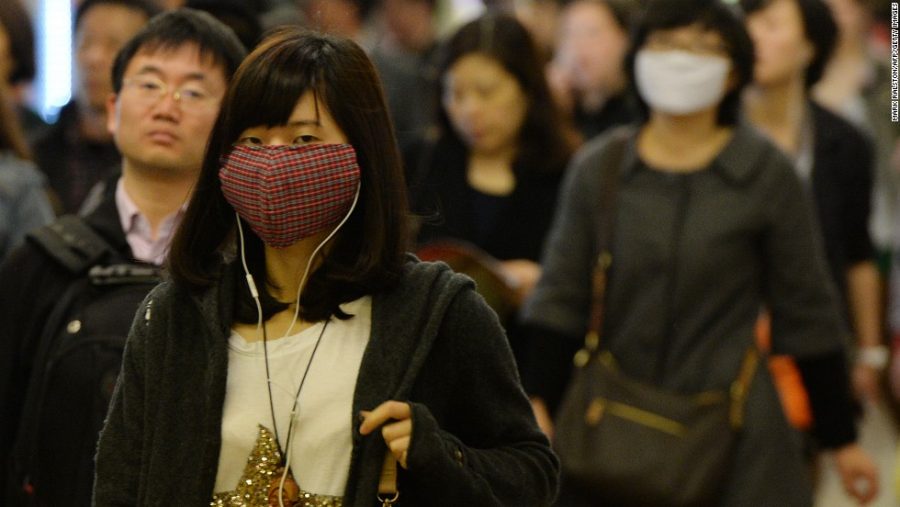Outbreak of Unidentified Disease in Central China
Patients Have Been Diagnosed With an Incurable Disease
Women wear facemasks as the city’s commuters protect themselves against the H7N9 bird flu virus in the downtown area of Shanghai in 2013 (Photo courtesy of CNN).
January 14, 2020
One man has died due to a new unidentifiable and incurable strain of pneumonia which has infected dozens of people in the central Chinese city of Wuhan, leading the rest of Asia to be on high alert. Health authorities have put the infected citizens in quarantine and hospitals have been extremely cautious.
Although only one death has been reported thus far, almost 60 patients have contracted the disease. According to a statement made by the Wuhan Municipal Health Commission, a total of 59 cases of the illness have been reported in the city Wuhan, Hubei Province of China. Seven of the patients are in critical condition as of Sunday. Some of the patients operated stalls at the Huanan Seafood market, but according to Wuhan Municipal Health Commission, the seafood stalls have nothing to do with the illness; “An epidemiological survey showed that some patients were operating households in Wuhan South China Seafood City (South China Seafood Wholesale Market). As of now, preliminary investigations have shown no clear evidence of human-to-human transmission and no medical staff infections.” All of the patients are in quarantine, and the 163 people who had been in close contact with them have been placed under medical observation. The World Health Organization states that symptoms include “…fever, with a few patients having difficulty in breathing, and chest radiographs showing invasive lesions of both lungs.” Eight patients had recovered and been discharged from hospital as of Wednesday, and no deaths have been reported, according to CCTV.

The Wuhan Municipal Health Commission put out a separate statement on Saturday notifying the public of the 61-year-old patient’s death. The Commission stated, “The patient was a 61-year-old male. He was admitted to the hospital due to respiratory failure and severe pneumonia. He also had abdominal tumors and chronic liver disease…On the evening of January 9, 2020, his heartbeat stopped and he died after rescue. Etiological results suggest that the new coronavirus is positive for nucleic acid. The deaths were diagnosed as severe pneumonia, acute respiratory distress syndrome (severe), septic shock, multiple organ failure, severe acid-base metabolism disorders, and liver cirrhosis. The immediate cause of death was respiratory circulation failure.”
The following response measures have been reported by The World Health Organization: “National authorities have reported the following response measures: One hundred and twenty-one close contacts have been identified and are under medical observation; The follow-up of close contacts is ongoing; Pathogen identification and the tracing of the cause are underway; Wuhan Municipal Health Commission carried out active case finding, and retrospective investigations have been completed; Environmental sanitation and further hygiene investigations are underway.”
According to scientists, the disease is from the same family of viruses as the deadly severe acute respiratory syndrome (SARS). There have been no reports of SARS since 2004, but according to the Centers for Disease Control and Prevention, in 2003 when SARS was first reported in Asia “The illness spread to more than two dozen countries in North America, South America, Europe, and Asia before the SARS global outbreak of 2003 was contained.” Between November 2002 and July 2003, an outbreak of SARS in southern China caused an eventual 8,098 cases, resulting in 774 deaths reported in 37 countries, with the majority of cases in China and Hong Kong, which had a 9.6% fatality rate (World Health Organization).

On Thursday, state broadcaster CCTV reported that a new coronavirus in 15 of 57 patients with the illness in the central city of Wuhan has been found saying it has been preliminarily identified as the pathogen for the outbreak. Coronaviruses are a large family of viruses that cause illnesses ranging from the common cold to SARS, according to the World Health Organization. Some coronaviruses transmit easily from person to person, others do not.
The World Health Organization put out a statement on Thursday, noting that China’s preliminary identification of a novel virus in a short period demonstrates the country’s “increased capacity to manage new outbreaks.” They also stated that “Further investigations are also required to determine the source, modes of transmission, extent of infection and countermeasures implemented.” The World Health Organization will continue to monitor the situation and advises against the application of any travel or trade restrictions on China based on the information currently available.
There was another case reported on January 8 in Bangkok, a traveler from China arrived in Bangkok and tested positive for the novel coronavirus linked to the outbreak in Wuhan, Thai officials said. According to Bloomberg, the patient was admitted to Bamrasnaradura Infectious Diseases Institute, and has since recovered and is ready to be discharged. This was the first case reported outside of Wuhan, causing panic in other parts of Asia. However, Antuin Charnviakul, Thailand’s deputy premier and health minister, said in a statement that he advises the public not to panic: “I’d like to ask the public not to be alarmed. The detection of the patient shows that we have an efficient system of surveillance. We’re confident that we can control the situation.”
According to CNN, across Asia, there have been other cases of the disease reported. On Wednesday, South Korea reported a suspected case linked to the Wuhan pneumonia, according to the Korea Centers for Disease Control and Prevention. According to CNN, the patient, a Chinese woman had visited Wuhan in December and had been isolated and is undergoing treatment and further tests. In Hong Kong, 38 people have been found with fever or respiratory symptoms after traveling from Wuhan, according to the city’s Hospital Authority. Among them, 21 have been discharged and so far none has been linked to pneumonia in Wuhan. In Singapore, travelers arriving from Wuhan are also required to go through temperature screening, according to the Ministry of Health. Doctors have been alerted to look out for suspected cases of pneumonia among people who recently returned from there.

It is not likely that the disease will travel outside of central China, let alone spread to the rest of Asia or the rest of the world. The illness seems to be well contained, but it never hurts to take precautions, especially with the upcoming flu season in the United States predicted as one of the deadliest in decades. Dr. Anthony Fauci, director of the National Institute of Allergy and Infectious Diseases, said while it’s impossible to predict how the flu will play out, the season could be as severe as the 2017-2018 flu season, which was the deadliest in decades, according to the US Centers for Disease Control and Prevention.
“The initial indicators indicate this is not going to be a good season — this is going to be a bad season,” Fauci said. So far this season, at least 2,900 people in the US are estimated to have died of the flu, according to data released Friday by the CDC.



